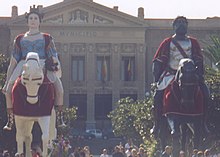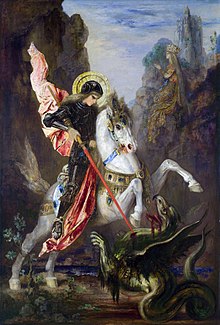Legend
The legend is a narrative about supernatural or natural facts or a mixture of both that is transmitted from generation to generation, orally or in writing.
It is located in a time and place similar to that of the members of a community, which adds a certain credibility to the story. Supernatural elements such as miracles, fairy creatures or from beyond the grave, etc. may appear. And these events are presented as real and are part of the vision of the world proper or emic of the community in which it originates.
In their process of transmission through oral tradition, legends often experience deletions, additions or cultural modifications that give rise to a whole world of variants. One of the most common is the "Christianization" of pagan legends, or their adaptation to children's vision, degrading to being simple folklore but thanks to this enduring, although in a disfigured way, since the change of times has reduced the ancient worldviews, beliefs and customs to this area.
Concept
The Brothers Grimm defined legend as a folk tale with historical grounds. A modern professional definition has been proposed by folklorist Timothy R. Tangherlini in 1990:
Typically, legend is a short traditional narrative consisting of a single episode, highly ecotipified, carried out in a conversational way, which reflects a symbolic psychological representation of popular belief and collective experiences and serves as a reaffirmation of the values commonly accepted by the group to whose tradition belongs.
Contrary to myth, which deals with gods, legend deals with men who represent archetypes (characteristic human types), such as the hero or the wise old man, as can be seen for example in Greek heroic legends and in the Arthurians.
Etymology and history
The word legend comes from the Latin verb legere, whose meaning varied between choose (the meaning from which choose) and read. In medieval Latin, the gerundive of this verb, legenda, was used to mean (something) to be read when the term was applied, especially in Catholicism, to the hagiographies or biographies of the saints. For example, Santiago de la Vorágine composed his Legenda aurea as a saint's day with the life and miracles of some 180 martyrs and saints, although with so little historical and philological precision and with such fantastic etymologies that little by little it lost credibility, except among painters and illustrators fascinated by their imagination, which stimulated iconography. He was based on the canonical gospels, the apocrypha and on the writings of Augustine of Hippo and Gregory of Tours, among others.
With the advent of the Protestant Reformation in the 16th century, the term legend took on a new character of non-historical narrative. English Protestants present a note of contrast between the "real" of the reform, whose "authentic" they appeared in John Foxe's Book of Martyrs, as opposed to the fanciful accounts of Catholic hagiography. In this way, the legend gains its modern connotation of storytelling undocumented and spurious. And so it is very likely that, in the Spanish language, the modern conception of legend and the legendary has been taken from these English models, especially since 1850.
The term ends up also encompassing educated literary productions of romanticism that, although they are inspired by popular traditions or their characteristic motifs, are not traditional stories. Several authors of this period wrote literary legends of this type in both prose and verse. The most celebrated were the Duke of Rivas, José Zorrilla, Gustavo Adolfo Bécquer and José Joaquín de Mora.
Origins of legends
Jean-Pierre Bayard in his History of Legends lists some ten theories relating to the origin of legends. Anthropological theory, supported by Henri Gaidoz, Wilhelm Mannhardt and Edward Tylor, postulates that legends originated from primitive human thoughts, remnants of elemental religions and cultures. The astral or naturalist theory considers etiological tales and legends as deifying the great manifestations of nature. The mythological theory is proposed by Grimm who attributes the creation of the stories to the prehistoric childhood of the homeland, Angelo De Gubernatis, to a childish naturalism, Schelling, to the individual conscience of the people who adds religious meaning to the legends created. Linguistic theory considers that legends come from the transmission of stories between various peoples who borrow words from other cultures, distort them, which obscures the original primitive meaning and gives rise to new stories.
Features
A legend, unlike a tale or a myth, is always linked to a precise element and focuses on the integration of this element into the everyday world or the history of the community to which it belongs. Contrary to the tale, which is located within a time («Once upon a time...») and a place (for example, the Castillo de irás y no volverás), agreed upon and imaginary, the legend It usually takes place in a precise and real place and time, although fictitious elements appear in them (for example, fabulous creatures, such as mermaids or dragons).
Like the myth, the legend is etiological, that is, its essential task is to provide a foundation and explanation to a certain culture. Its central element is a feature of reality (a custom or the name of a place, for example) whose origin is intended to explain or justify.
Legends are often grouped in cycles around a character, as is the case with the cycles of legends around King Arthur, Robin Hood, El Cid Campeador or Bernardo del Carpio. And sometimes they become sequentially integrated into extensive narrative works such as epics or novels.
They almost always contain a historical core, amplified to a greater or lesser degree with imaginative episodes. Their appearance may depend on involuntary motivations, such as errors, misinterpretations (the so-called popular etymology, for example) or exaggerations, or by the conscious action of one or more people who, for self-interested reasons (for example, Gonzalo de Berceo) or purely aesthetic, develop the original embryo.
When a legend contains elements taken from other legends, it is called "legend contamination".
Classification
They can be classified in two ways:
For its theme:
- Historical legends: they are all those who narrate events that occurred in wars, in conquests or in battles.
- Etiological legends: clarify the origin of the elements inherent in nature, such as rivers, lakes and mountains.
- eschatological legends: about beliefs and doctrines concerning the life of ultratumb or trips to the underworld (Nekyia).
- Religious legends: stories of righteous and sinners, pacts with the devil, episodes of the life of saints.
By its origin:
- Urban legends: they belong to contemporary folklore, they circulate from mouth to mouth, through generations.
- Rural Legends: only valid legends in the field, because they have no place or adaptation for the urban ones.
- Local Legends: it is a popular narrative of a municipality, county or province.
Some legends can be classified in more than one group, since due to their theme they address more than one topic. An example of this would be a legend about a supposed way to contact a deceased loved one, which could be classified as both an urban legend and an eschatological legend.
Legends in Spain
Very dissimilar traditions were mixed in the Iberian Peninsula: Celtic, Iberian, Roman, Visigothic, Jewish, Arab (and with the Arabs, Indian traditions) in the most diverse languages.
Several legends appear in the Ballads and, through it, in classical Spanish theater. A true breeding ground for legends is the work of Cristóbal Lozano and the courtly novel of the Baroque. Numerous ecclesiastical writers compiled pious legends and traditions in different collections, the best known of which, but not the only one, is the Flos sanctorum.
But from the 19th century the romantics began to show interest in collecting, studying or even imitating them. In 1838 some Jerez Legends and novels were already published; in 1869, 1872 and 1874 successive editions of some Legends and popular traditions of all countries about the Blessed Virgin Mary, collected and ordered by a Religious Society appeared. In 1853 Agustín Durán, who had already published the two volumes of his monumental General Ballads or Collection of Castilian Romances (BAE, t. X and XVI), published the Leyenda de las tres toronjas del orchard of Love. Ángel de Saavedra, Duke of Rivas, cultivated the genre of the legend in verse and Fernán Caballero translated German legends and compiled and brought together collections of the Spanish ones. Those by Gustavo Adolfo Bécquer, both those published and those compiled posthumously, are among the most expressive in prose, but the legends in verse by José Zorrilla and José Joaquín de Mora do not detract either. After Washington Irving, the Arabist Francisco Javier Simonet published in 1858 The Alhambra: Arab historical legends; José Lamarque de Novoa published Historical Legends and Traditions (Seville, 1867); Antonia Díaz Fernández de Lamarque, Wilted flowers: ballads and legends (Seville, 1877); Manuel Cano y Cueto dealt with the legends about Miguel Mañara (1873), and to these names many others no less important should be added, such as María Coronel, Josefa Ugarte y Casanz, Teodomiro Ramírez de Arellano, José María Goizueta, etc.
In 1914, the important center for folklore studies that was then Seville sponsored the translation of The formation of legends by Arnold van Gennep. In 1953 the appearance of the Anthology of Legends of Universal Literature by the philosopher Vicente García de Diego was a milestone, with a dense and extensive preliminary study and a selection of the best Spanish legends grouped by region., and other countries around the world. The last important contribution to these studies is undoubtedly that of Julio Caro Baroja, a great scholar of cordel literature, Of archetypes and legends (Barcelona: Círculo de Lectores, 1989).
Contenido relacionado
Rosalia de castro
Pesaro
Acrostic




